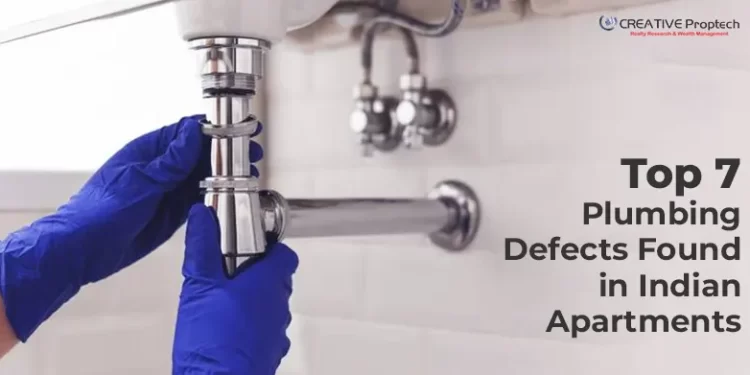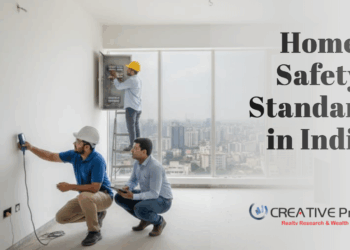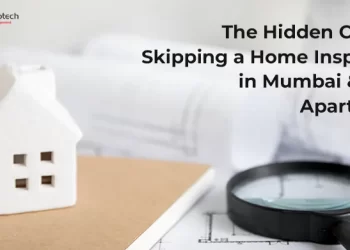Plumbing issues are among the most common—and most expensive—problems faced by apartment owners and tenants in India. Whether you’re moving into a new flat, buying a resale property, or simply planning a renovation, identifying plumbing defects early can save you money, stress, and structural damage in the long run.
Here’s a breakdown of the top 7 plumbing defects frequently found in Indian apartments, and why a professional home inspection can be your best defense.
Importance of Plumbing Checks in Home Inspections
A professional home inspection includes a thorough plumbing audit covering:
-
Water pressure testing
-
Leak detection using moisture meters
-
Floor slope and drainflow assessment
-
Checking alignment and installation of sanitary fittings
-
Valve, tap, and flush tank checks
These tools and methods are far more precise than visual checks during a site visit.
 1. Leaky Faucets and Fixtures
1. Leaky Faucets and Fixtures
At first glance, a dripping tap might seem harmless. But constant leakage not only wastes water—it may signal defective cartridge valves, poor-quality installations, or worn-out washers. In premium apartments, faulty designer fittings can be even more expensive to repair.
Pro Tip: Check for consistent pressure and noise when turning the faucet on and off. If it feels too loose or noisy, it’s worth a deeper look.
2. Poor Drainage and Backflow Issues
Slow drainage in kitchen sinks, bathroom floors, or utility areas is a red flag. Common causes include improperly sloped drainage pipes, partial blockages, or poor grating design. Backflow of wastewater into bathrooms is particularly alarming during monsoon seasons or in lower-floor apartments.
Why It Matters: Persistent drainage problems can result in hygiene issues, foul smells, and eventually water seepage into flooring.
3. Concealed Pipe Leakages
In modern constructions, plumbing pipes are often concealed inside walls and floors. While this provides a cleaner finish, it makes detecting leaks difficult without the right tools.
Warning Signs Include:
-
Damp patches or discolored walls
-
Swollen skirting boards or wooden furniture near bathrooms
-
Mold or fungal growth behind tiles
How to Detect: Thermal imaging and moisture meters are the most reliable methods to catch hidden leaks early.
4. Incorrect Pipe Slope and Alignment
If drainage pipes are not laid at the proper gradient, wastewater won’t flow efficiently—causing clogs, odors, and long-term pipe damage. This is especially common in hastily built or budget-friendly projects where plumbing layout is rushed.
Key Risk Areas: Kitchen and bathroom outlet pipes, floor trap areas, and terrace drainage.
5. Low Water Pressure
While high-rises often use pressure pumps, inconsistent or low pressure on higher floors is still common. Reasons range from clogged aerators and partially closed valves to improper pipe sizing or faulty overhead tank connections.
Impact: Low pressure affects showers, geysers, and washing machines—reducing user experience and increasing wear on appliances.
6. Noisy or Vibrating Pipes
Water hammer or pipe vibration noises usually indicate poorly secured plumbing lines or abrupt valve closures. In the long run, this can damage pipe joints or fittings.
Common Causes:
-
Sudden opening/closing of taps
-
Inadequate pipe cushioning behind walls
-
Air gaps or pressure imbalance in plumbing layout
7. Faulty or Unsealed Floor Traps
In many Indian homes, floor traps are not properly sealed or aligned with drainpipes. This can lead to bad smells, mosquito breeding, and gurgling sounds in bathrooms.
Checkpoints:
-
Is the grating flush with the tile level?
-
Do water pools form after use?
-
Do you notice a sewage smell after rains?
Conclusion
Plumbing may be out of sight, but it should never be out of mind. Ignoring even minor plumbing defects can lead to water damage, mold infestation, and expensive repairs—especially in cities with extreme weather like Mumbai, Pune, or Bangalore.
Getting a professional home inspection before possession or purchase ensures that your apartment’s plumbing is efficient, safe, and future-proof.
FAQs
1. Do new apartments also have plumbing issues?
Yes, issues like loose fittings or hidden leaks are common even in new constructions.
2. Can I check plumbing defects myself?
You might spot obvious ones, but hidden problems need professional tools.
3. When should I get a plumbing inspection done?
Before possession or before buying a resale flat is ideal.
4. What do professionals check in a plumbing inspection?
Water pressure, leaks, drain slope, fixture alignment, and more.
5. Will they check my taps, flush, and geyser?
Yes, all fittings and fixtures are covered in a full inspection.






